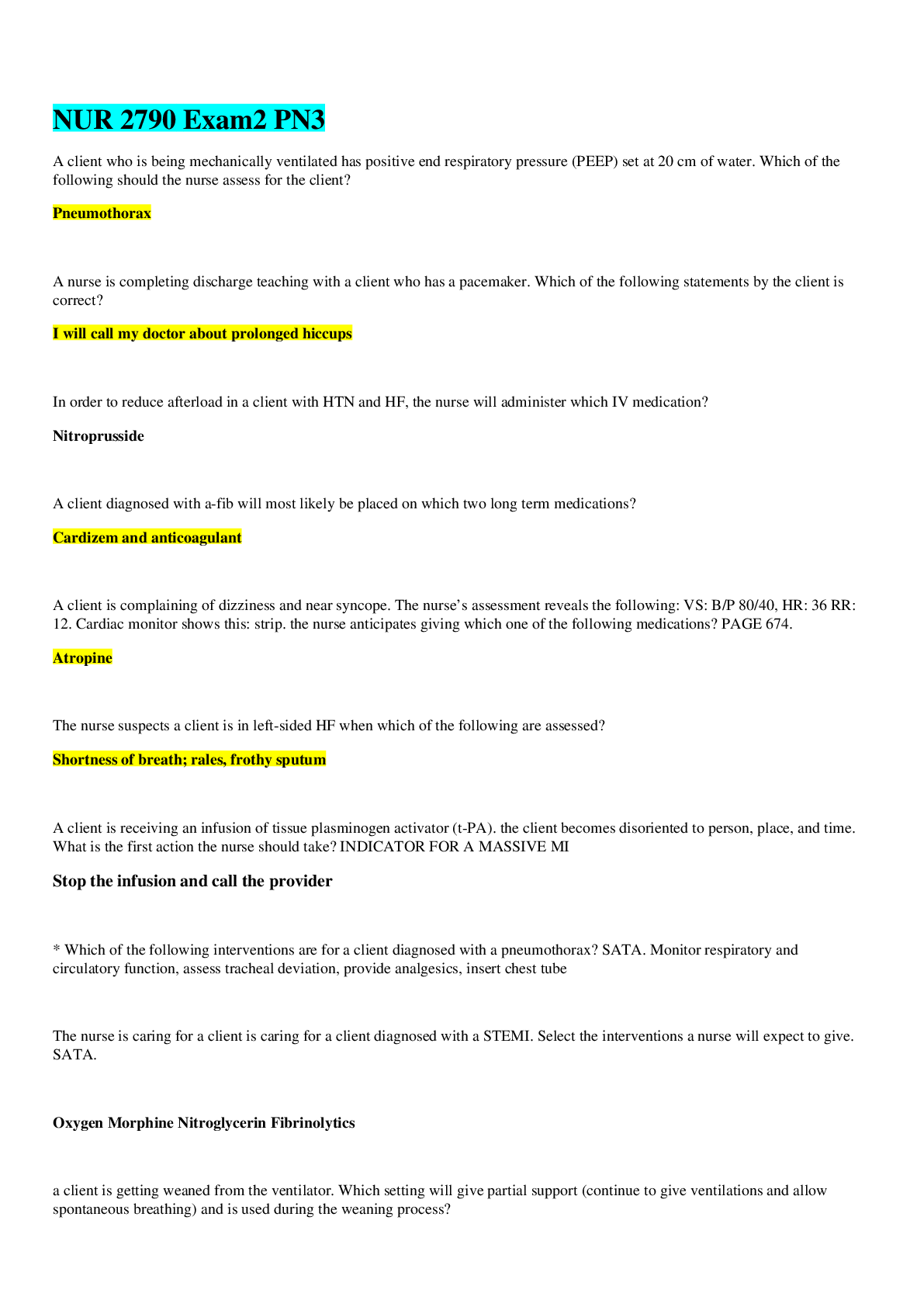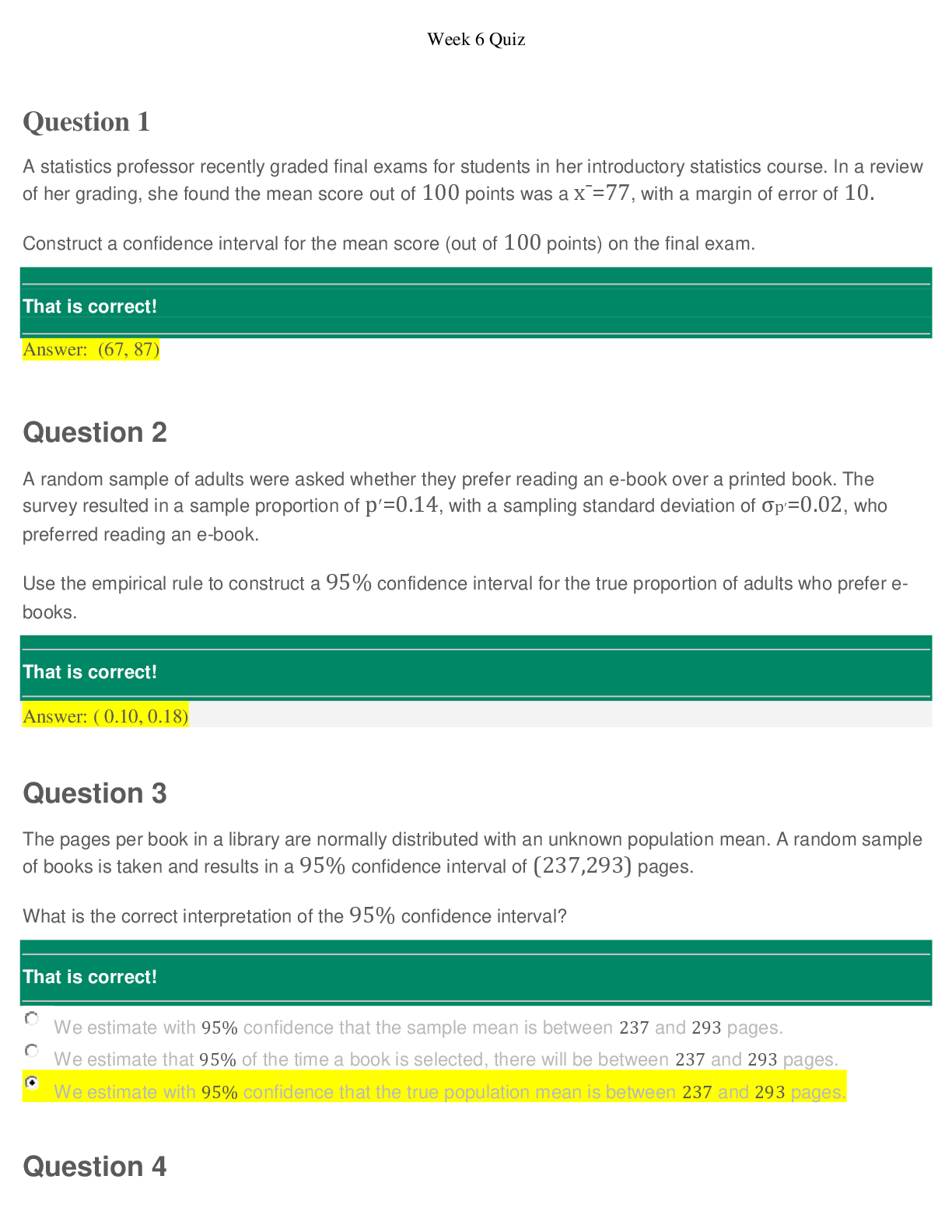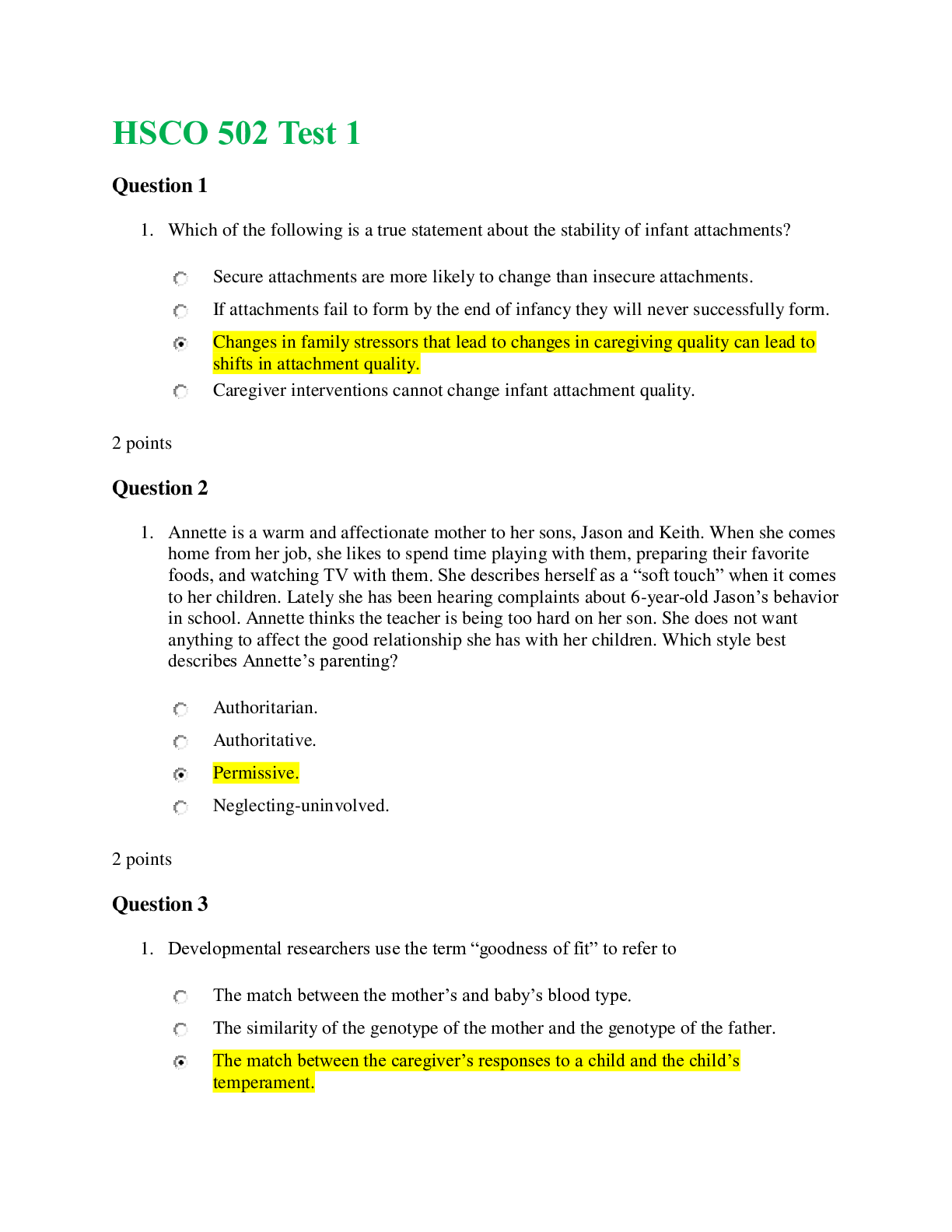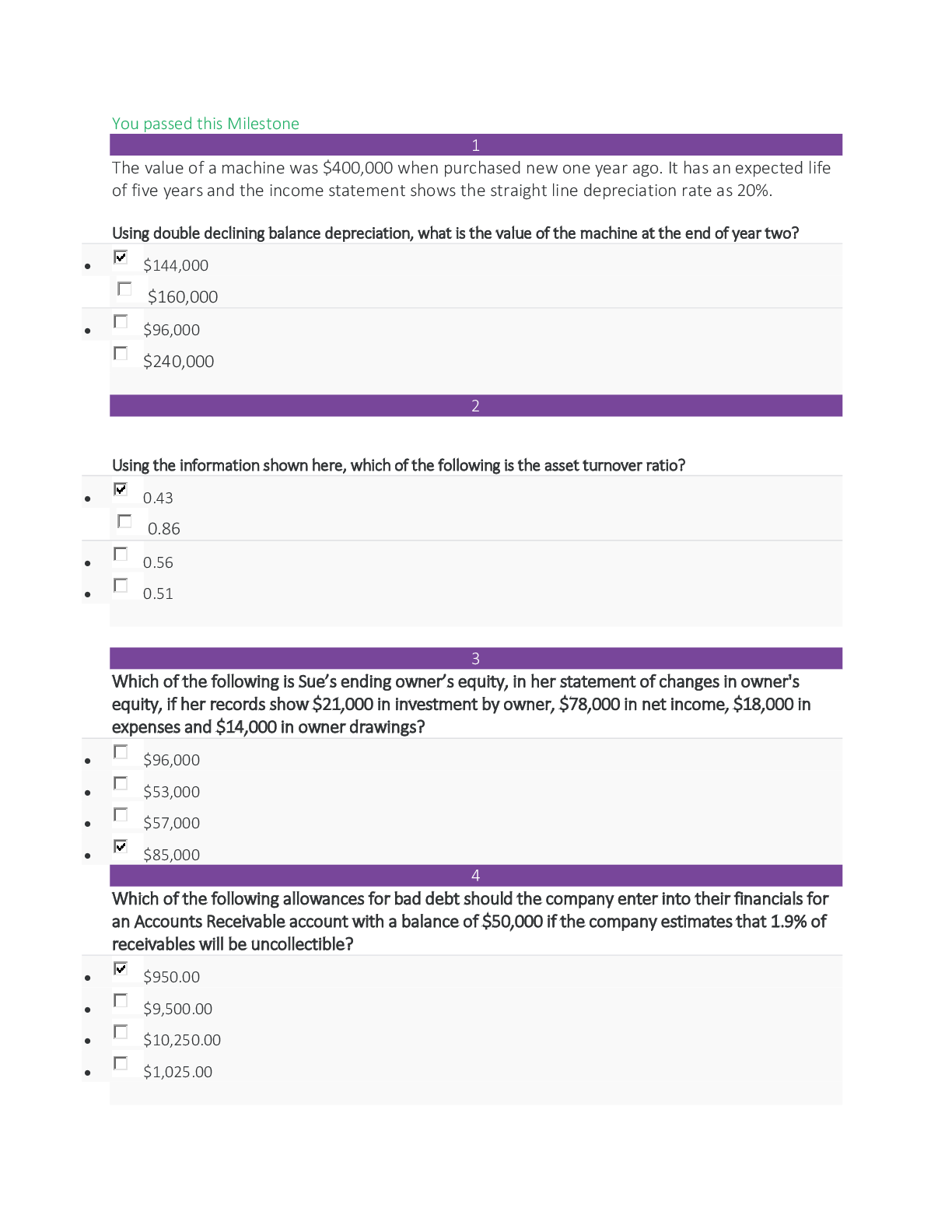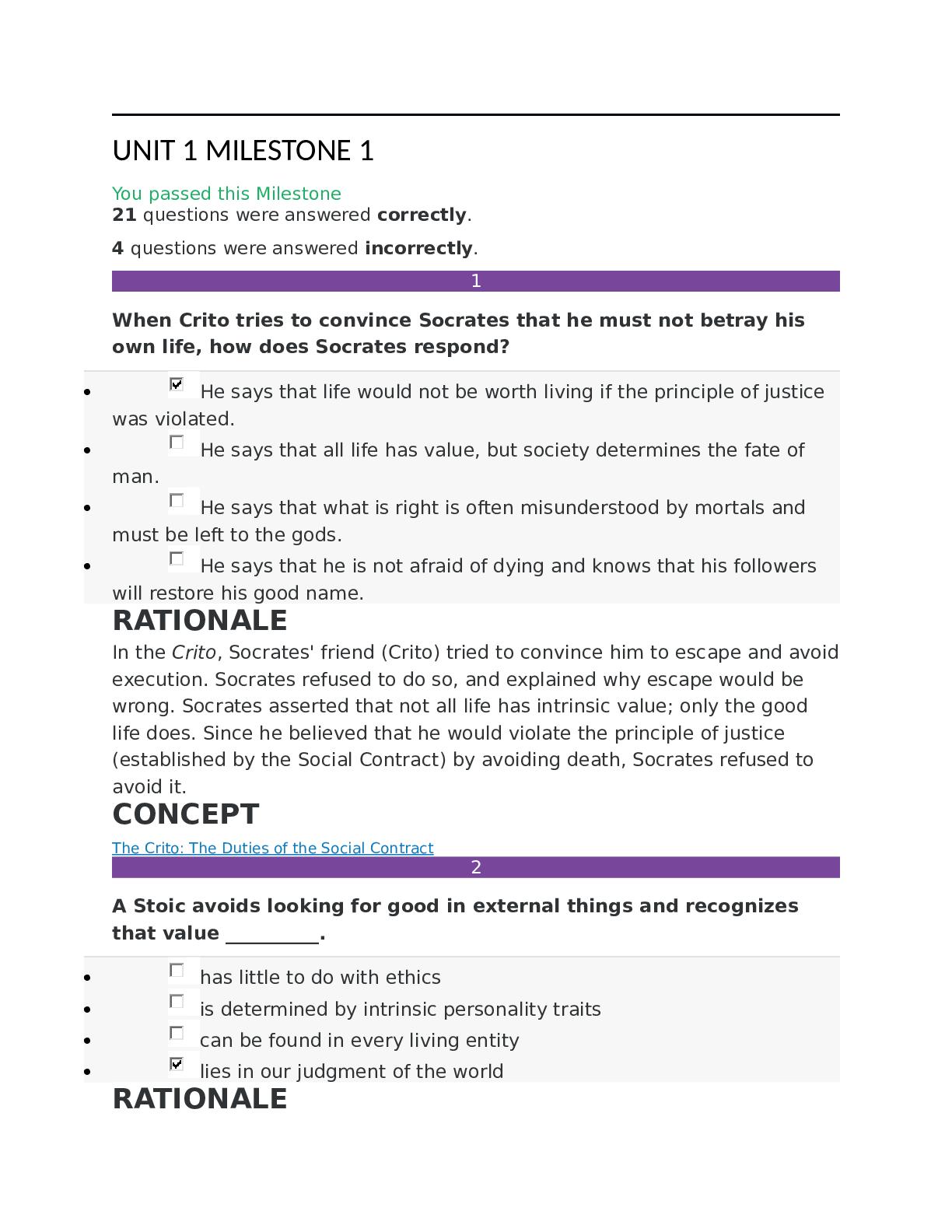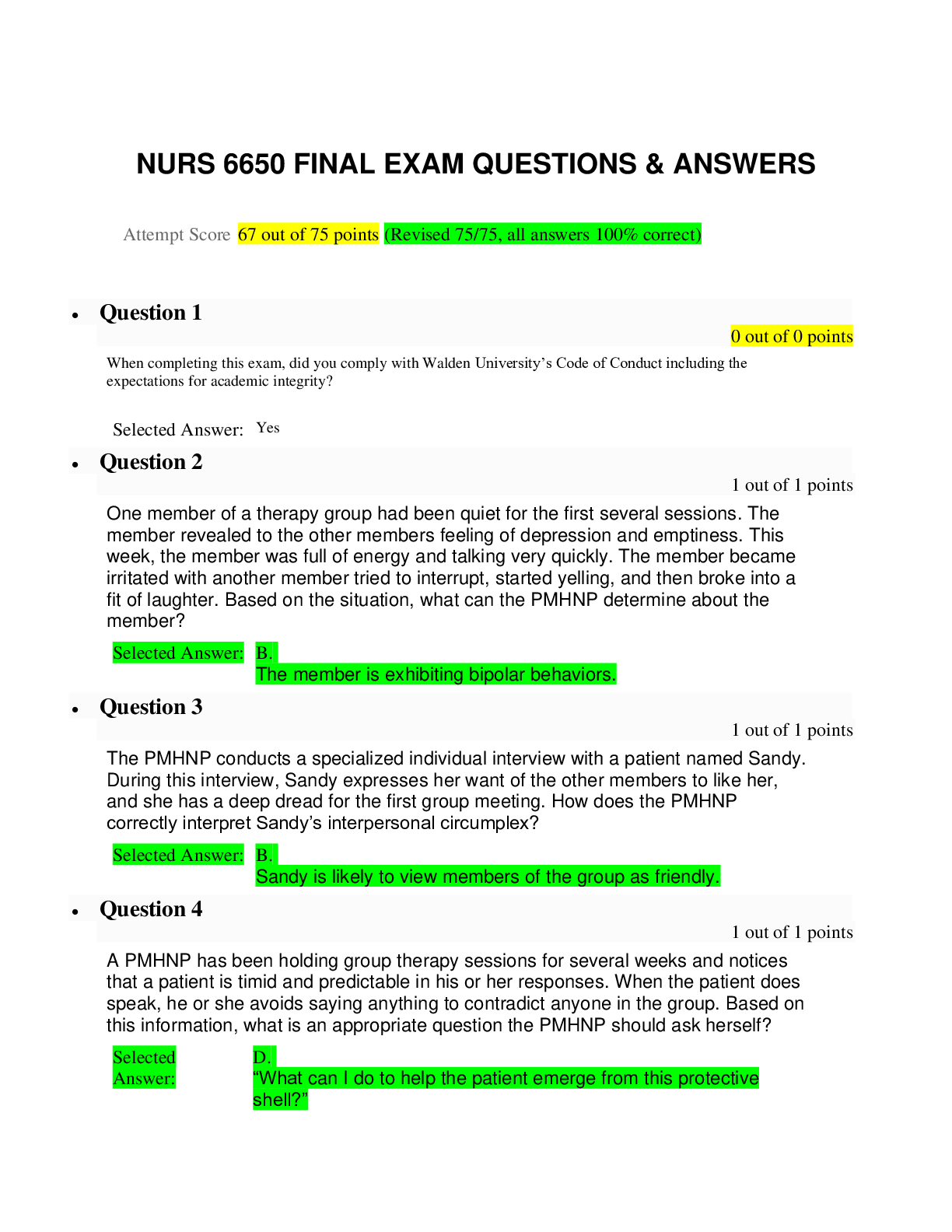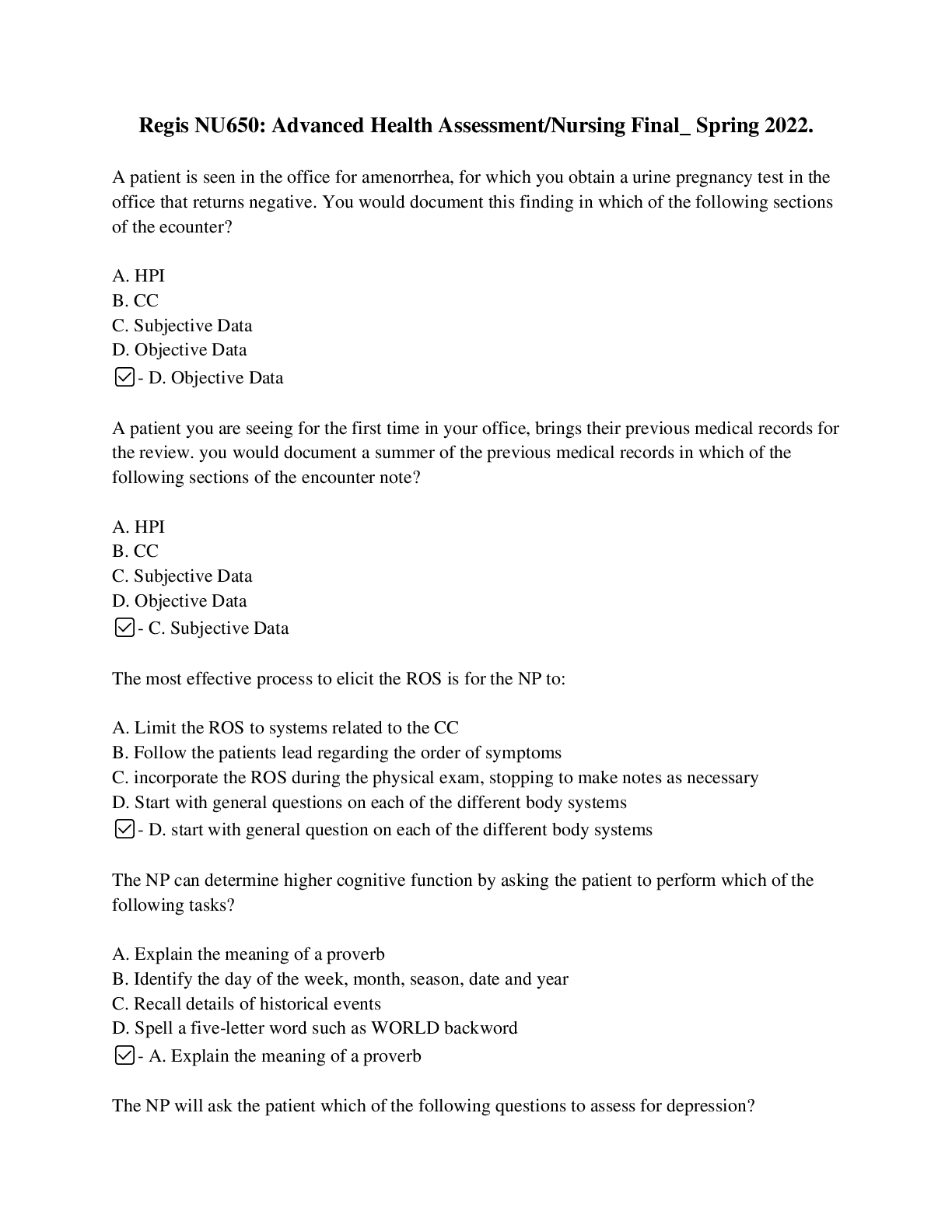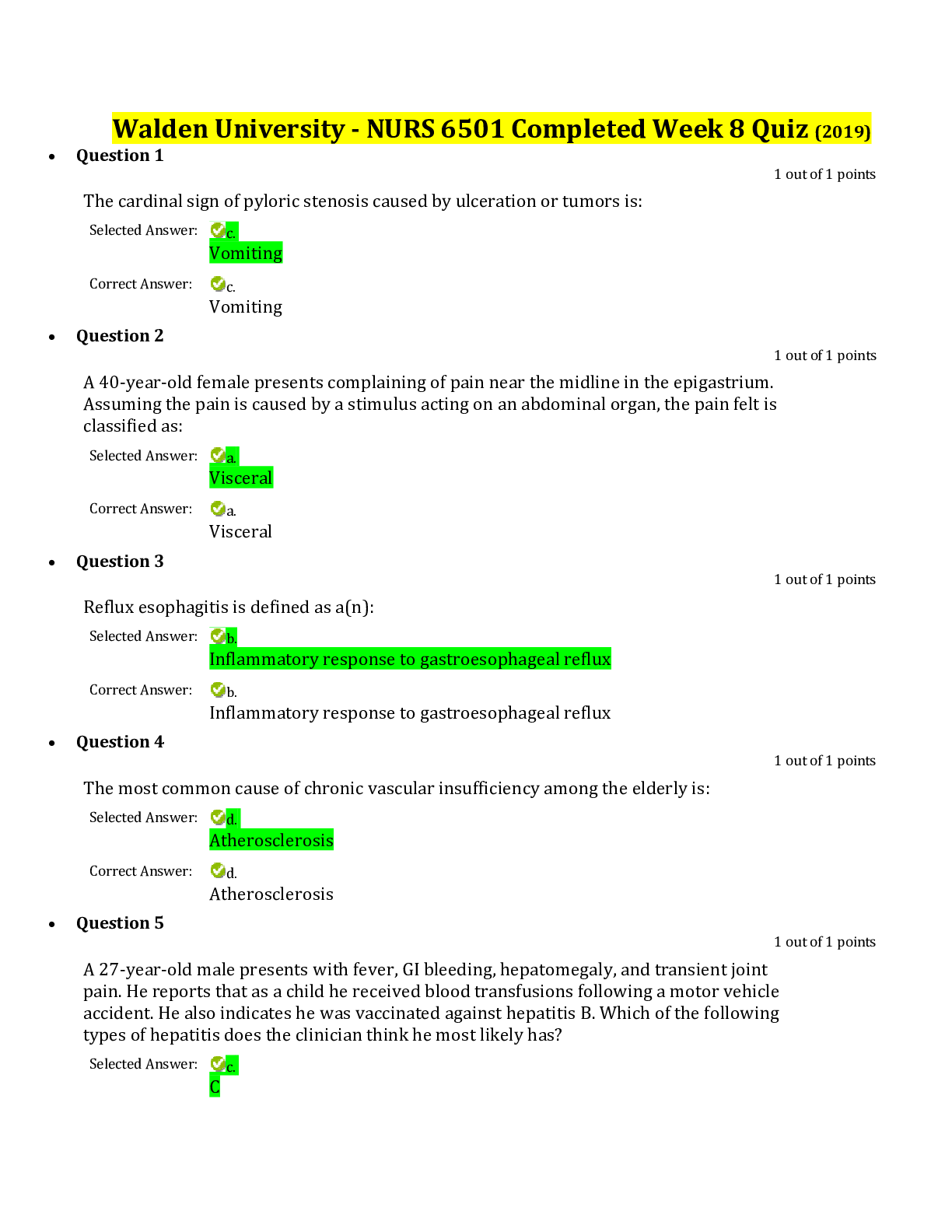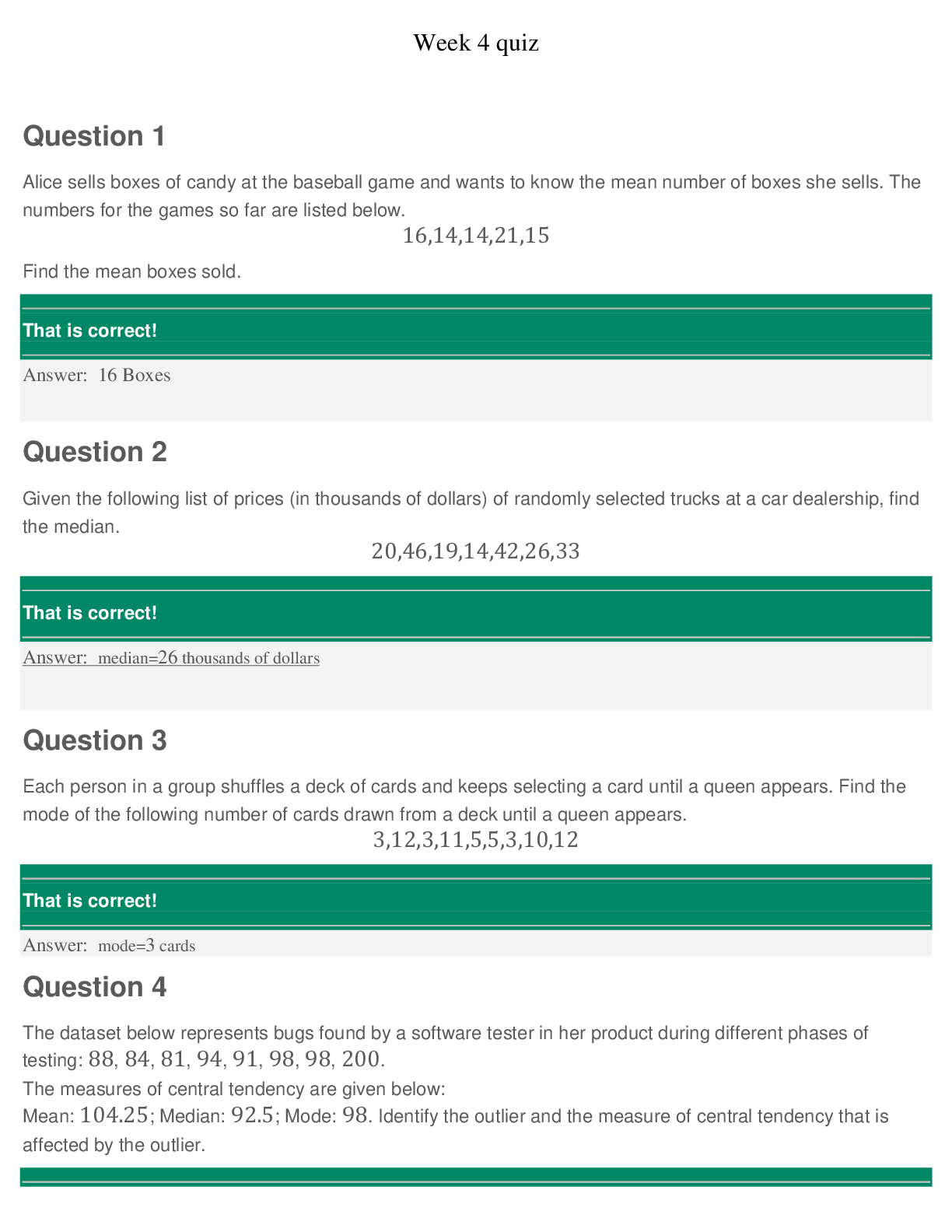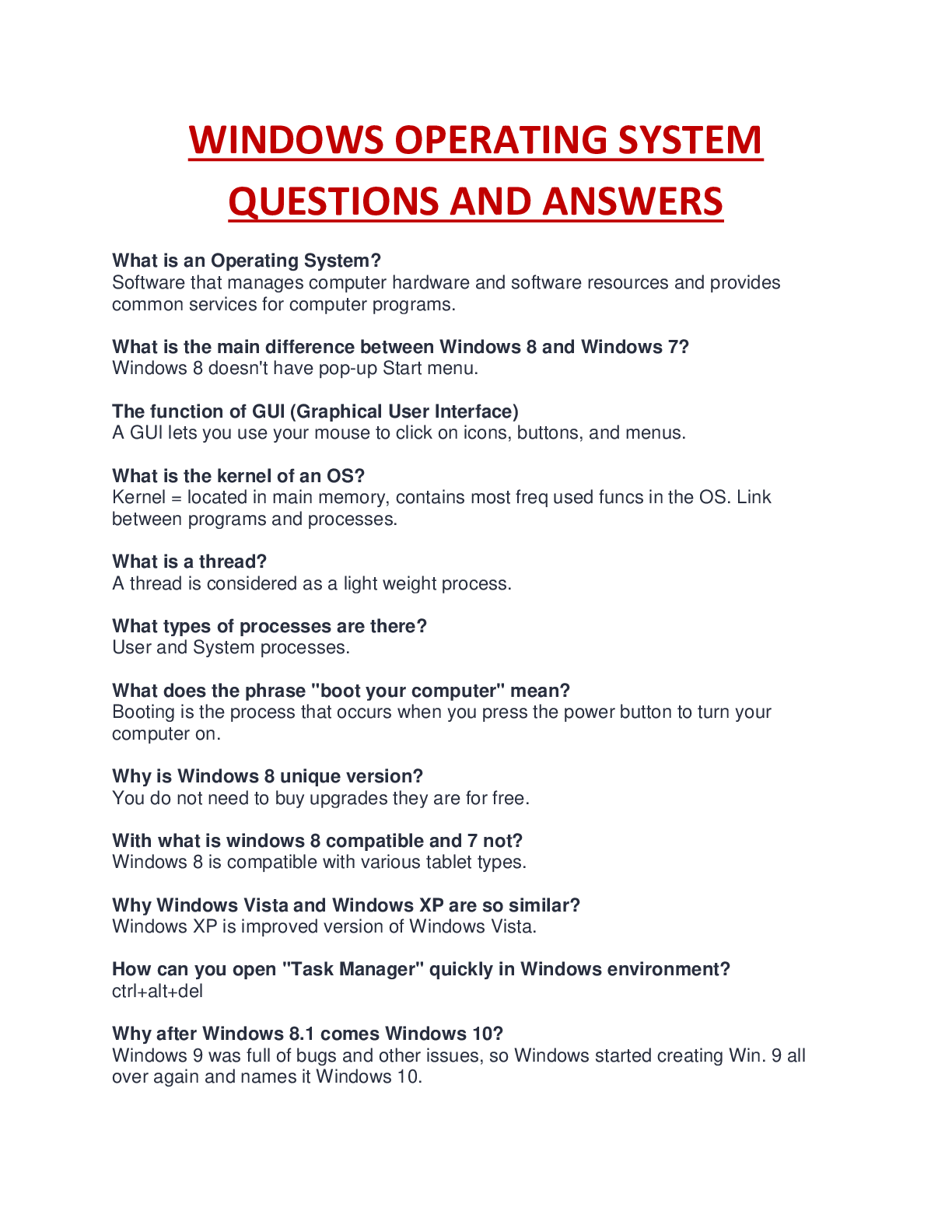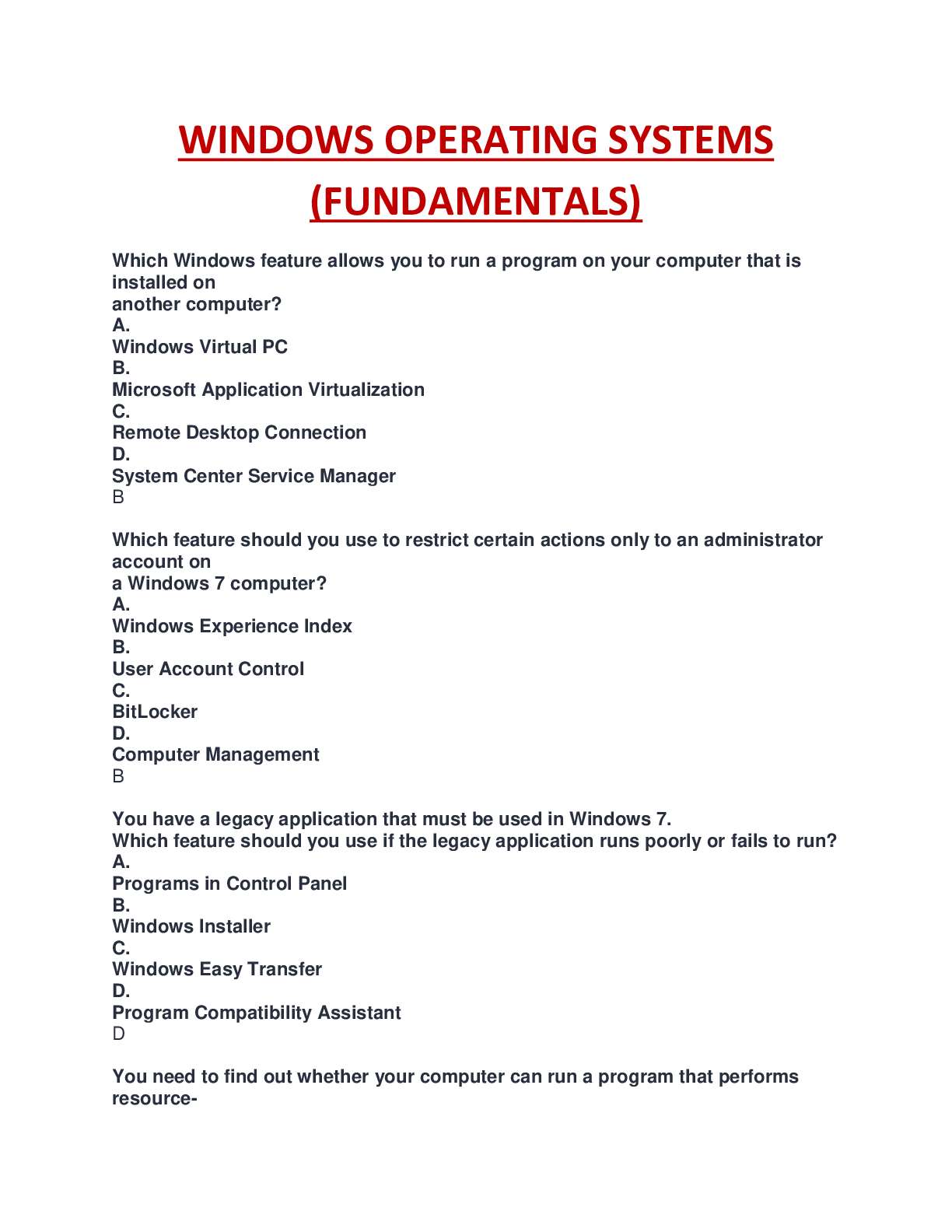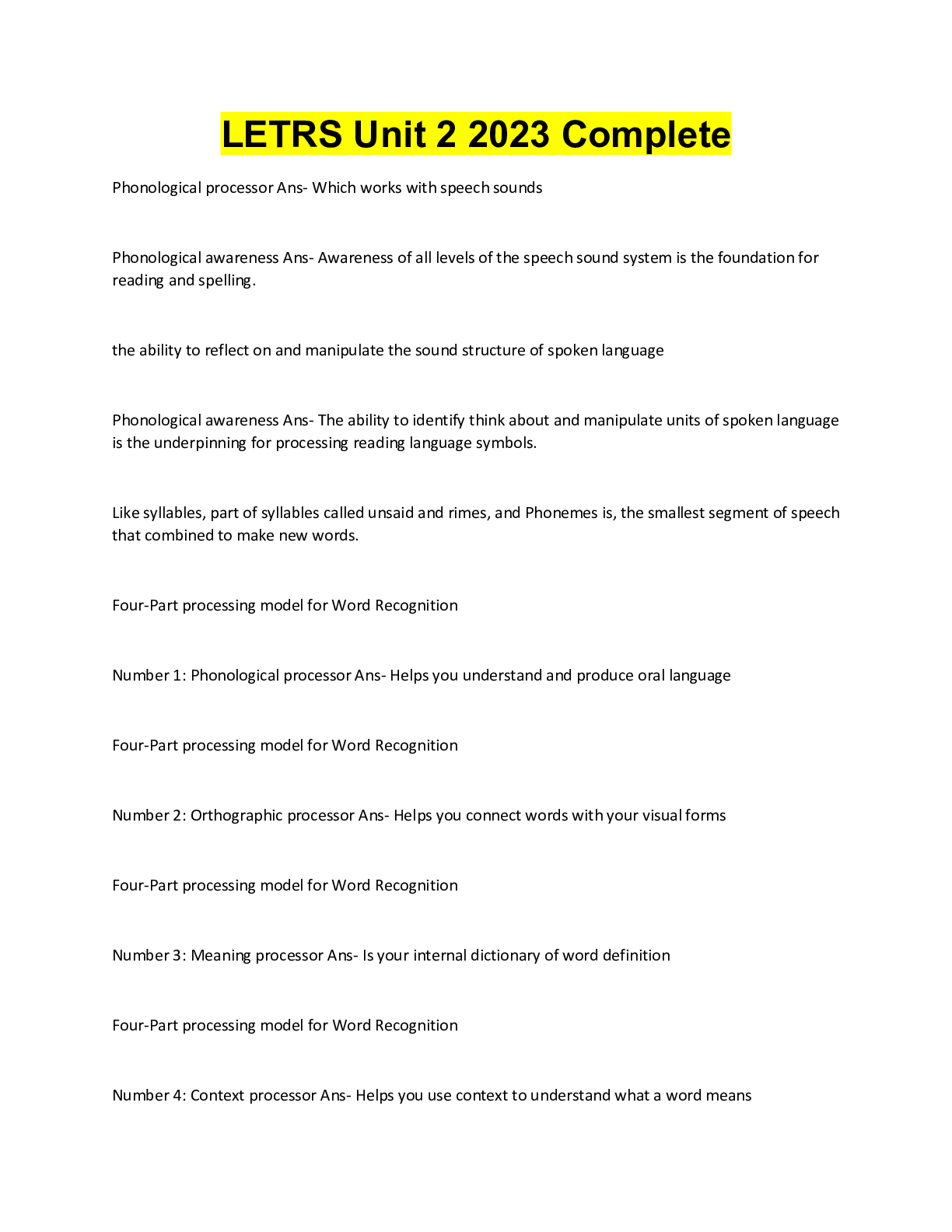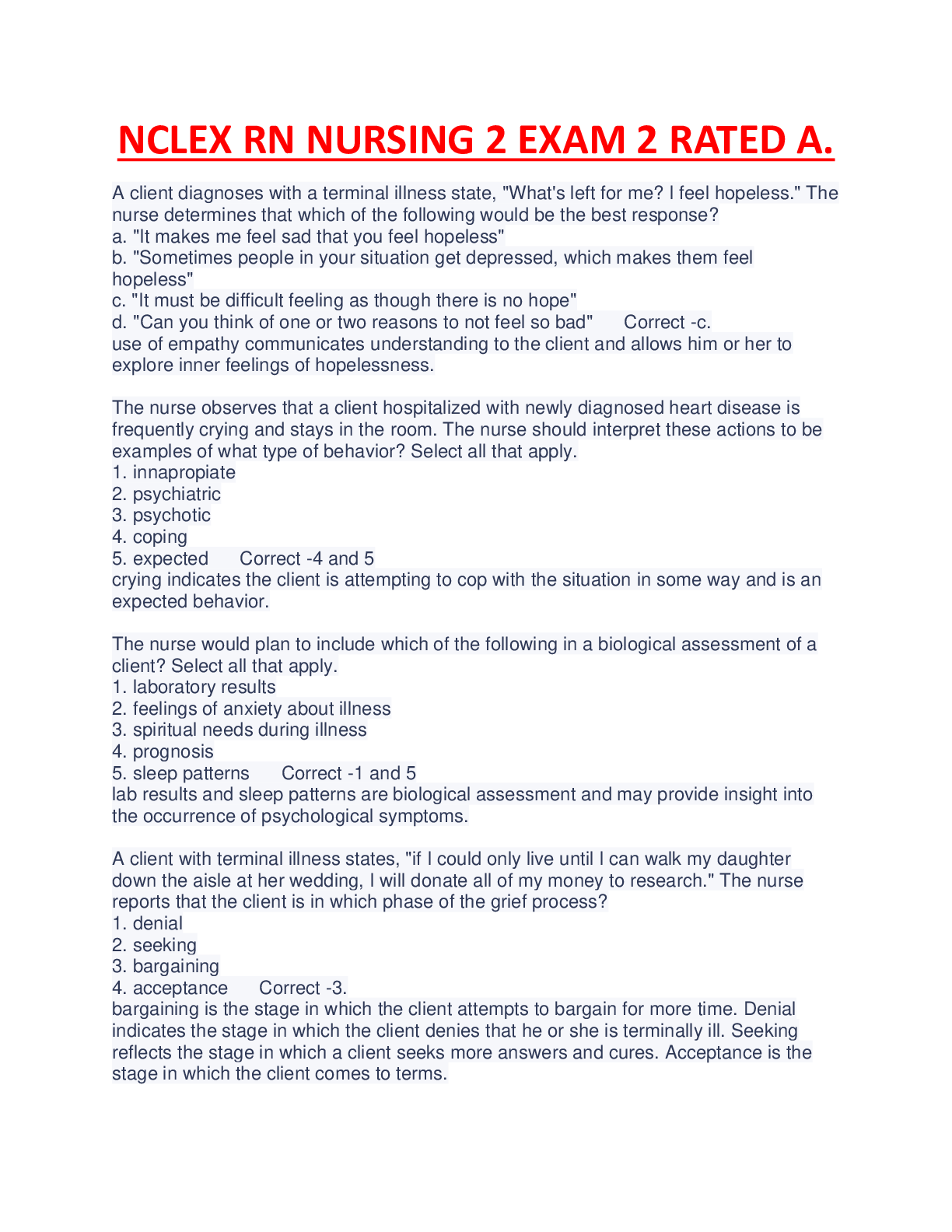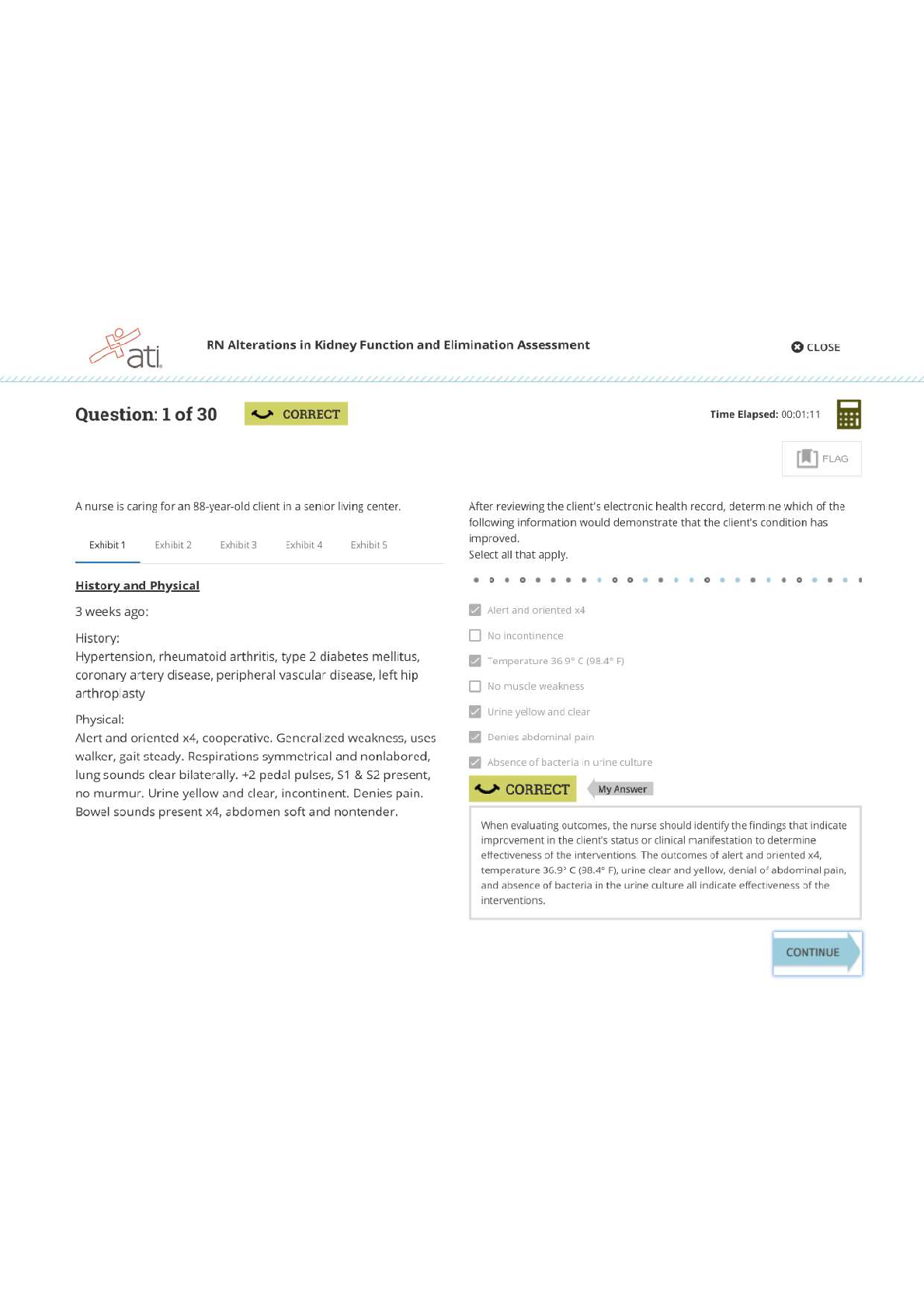*NURSING > EXAM > PN 2 Exam 2_ Professional Nursing 2 Exam 2 2023 Complete Solution, Graded A. Rasmussen College. (All)
PN 2 Exam 2_ Professional Nursing 2 Exam 2 2023 Complete Solution, Graded A. Rasmussen College.
Document Content and Description Below
PN2 Exam 2 Answers. 1. The nurse identifies the nursing diagnosis of decreased cardiac output related to valvular insufficiency for the patient with infective endocarditis (IE) based on which assessm... ent finding(s)? a. Fever, chills, and diaphoresis b. Blood pressure of 85/48 mmHg c. Petechiae on the inside of the mouth and conjunctiva d. Increase in heart rate of 15 beats/minute while walking. 2. A patient who has a history of pulmonary valve stenosis tells the healthcare provider, “I don’t have a lot of energy anymore, and both of my feet get swollen in the late afternoon.” Which of these problems does the healthcare provider conclude is the likely cause of these clinical findings? a. Acute pericarditis b. Peripheral arterial disease c. Deep vein thrombosis d. Right side heart failure 3. A patient is diagnosed with heart failure and is prescribed digoxin (Lanoxin) and furosemide (Lasix). Before administering the furosemide to the patient, which laboratory result should the healthcare provider to review? a. Serum calcium b. Serum potassium c. Serum sodium d. Serum phosphorous 4. You are educating a patient with newly diagnosed Vitamin B12 deficiency anemia. Which of the following statements indicate a need for further teaching? a. I will limit my intake of dried beans and citrus fruit. b. I will drink fluids with electrolytes while exercising. c. I will increase my intake of animal proteins and eggs. d. I will keep my follow up appointment with my provider. 5. You are providing patient education on their new medication, Amlodipine (Norvasc). Which statement by the patient indicates patient understanding? a. I will weigh myself daily at the same time every day. b. I will need to avoid grapefruit juice and grapefruit while taking this medication. c. I will need to avoid green leafy vegetables while taking this medication. d. I will take this medication only when I remember. 6. A nurse is assessing a client diagnosed with Buerger’s disease. While assessing this client and extremities, the nurse correlates which clinical manifestations with this disease process? a. ulcerations on digits and complaints of claudication b. Cold and pale, with bounding radial and pedal pulses c. Cyanotic, with hyporeflexive distal deep tendon reflexes d. Brownish, with hyperreflexive distal deep tendon reflexes 7. Which intervention suggested to the client with Raynaud’s disease is aimed at preventing worsening complications? a. “Take oral vasoconstrictive agents when you have symptoms.” b. “Wear warm clothing when exposed to cool temperatures.” c. “Avoid placing lotion on affected extremities.” d. “Check the pulses in your arms and legs daily.” 8. The graduate nurse is assessing her newly admitted client’s abdomen and notes a bruit upon auscultation. Which assessment technique by this nurse should be questioned in this client? a. Observe for movement of the abdominal wall b. Measure the client’s abdominal girth c. Assessing the client for abdominal and back pain d. Palpate and document if artery is found to have doubled in size 9. A client with atherosclerosis asks a nurse which factors are responsible for this condition. What is the nurse’s best response? a. “Injury to the arteries causes them to spasm, reducing blood flow to the extremities.” b. “Excess fats in your diet are stored in the lining of your arteries, causing them to constrict.” c. “A combination of platelets and fats accumulate, narrowing the lumen of the artery, reducing blood flow.” d. “Excess sodium from hypertension causes direct injury to the arteries, reducing blood flow and eventually causing obstruction.” 10. Which assessment finding does the nurse expect in the client with mitral valve prolapse? a. Rumbling apical diastolic murmur b. Chest pain and palpitations c. An S3 coupled with a high-pitched diastolic murmur d. Continuing, loud diastolic murmur radiating to the left axilla 11. A nurse is caring for a client who has heart failure and is taking Digoxin daily. The client refused breakfast and is complaining of nausea and weakness. Which of the following actions should be a priority for the nurse to take? a. Check the client’s vital signs and heart rhythm b. Request a dietician consult c. Suggest the client rest adequately before eating meals. d. Administer the ordered PRN antiemetic. 12. A nurse is reviewing the labs for a newly admitted heart failure patient and notes a K+ level of 5.6. Upon reviewing the patient’s medications, the nurse realizes which of the following medications most likely contributed to this electrolyte imbalance? a. Furosemide b. Hydrochlorothiazide c. Spironolactone d. Bumetanide 13. The nurse determines which client as at greatest risk for acidosis? a. The anxious client who is hyperventilating b. The young adult client with persistent vomiting c. The adult client with peptic ulcer disease d. The adult client with pneumonia 14. Which intervention will the nurse plan to implement to reduce a client’s pain during a sickle cell crisis? a. Encourage ambulation to promote circulation. b. Offer the client cool compresses for comfort. c. Keep the room temperature at a cool 68-72° F. d. Provide warm blankets and a warm environment. 15. A nurse is planning a diet for a client who is iron deficient. Which of the following foods high in iron should the nurse include in the plan? a. Oranges b. Cashews c. Red meat d. Yogurt 16. Which symptom is most characteristic of a factor VIII deficiency? a. Excessive bleeding from a cut b. Back pain c. Nausea and vomiting d. Temperature of 101° F 17. A nurse is caring for a client who has hemophilia A and hemarthrosis of the left knee. Which of the following actions should the nurse take? a. Administer low dose aspirin for mild pain. b. Apply heat to affected knee c. Prepare to administer IV fluids d. Assess client for s/s of bleeding 18. A client is admitted with arterial blood gas (ABGs) results of pH 7.30, PaCO2 60, HCO3 22. The nurse concludes this client has which acid-base imbalance?? a. Compensated Respiratory Acidosis b. Uncompensated Respiratory Acidosis c. Uncompensated Metabolic Acidosis d. Compensated Metabolic Acidosis 19. Which ABG values are expected with anxiety induced hyperventilation? a. pH 7.29; PaCO2 55 mm Hg b. pH 7.49; PaCO2 56 mm Hg c. pH 7.28; PaCO2 31 mm Hg d. pH 7.48; PaCO2 32 mm Hg 20. The nurse is caring for a client with COPD and is reviewing the new ABGs. Which of the following arterial blood gas values is consistent with fully compensated respiratory acidosis? a. pH 7.28, HCO3– 12 mEq/L, PCO2 45 mm Hg, PO2 96 mm Hg b. pH 7.36, HCO3– 17 mEq/L, PCO2 25 mm Hg, PO2 98 mm Hg c. pH 7.37, HCO3– 36 mEq/L, PCO2 65 mm Hg, PO2 78 mm Hg d. pH 7.48, HCO3– 12 mEq/L, PCO2 35 mm Hg, PO2 85 mm Hg 21. A nurse is assessing a client who is taking Lisinopril to treat hypertension. Which of the following findings is a priority to report? a. Dry cough b. Nausea c. Nasal congestion d. Swelling of the tongue 22. A home health nurse visits a client who has COPD and receives oxygen at 2L/min via nasal cannula. The client reports having difficulty breathing. Which of the following actions is the nurse’s priority? a. Increase the oxygen flow until O2 sats are above 94%. b. Assess the client’s respiratory status. c. Call 911 so the client can be admitted for possible pneumonia. d. Have the client increase fluid intake to promote expectoration of secretions. 23. The post-anesthesia care nurse is caring for a client who just had a mitral valve replacement surgery. The client’s blood gases are as follows: pH, 7.22; HCO3–, 21 mEq/L; PCO2, 65 mm Hg; and PO2 58 mm Hg. Which is the priority action by the nurse? a. Assessing the client’s airway b. Increasing the client’s oxygen flow rate c. Checking the client’s oxygen saturation level d. Documenting the findings as respiratory acidosis in the client’s chart and notify the physician 24. A client comes into the E.R. with acute shortness of breath and a cough that produces pink, frothy sputum. Admission assessment reveals crackles and wheezes, a BP of 85/46, a HR of 122 BPM, and a respiratory rate of 38 breaths/minute. The client's medical history included DM, HTN, and heart failure. Which of the following disorders should the nurse suspect? a. Pulmonary edema b. Pneumothorax c. Pulmonary embolism d. Pulmonary hypertension 25. Isoniazid (INH) and Rifampin (Rifadin) have been prescribed for a client with tuberculosis. A nurse reviews the medical record of the client. Which of the following noted in the client's history would require the nurse to question the order for these medications? a. Heart disease b. Allergy to penicillin c. Rheumatic fever d. Hepatitis C 26. The nurse is teaching a female patient about her new prescription for spironolactone. Which statement indicates the teaching needs for further education? a. “I will use salt substitutes to lower my sodium intake.” b. "I will limited my intake of foods that are high in potassium." c. "I will call my doctor if I begin having chest palpations." d. "I will take this medication each morning." 27. The nurse is assessing a client diagnosed with asthma. The client's initial breath sounds heard by the nurse consisted of wheezing but have diminishing until no audible sounds are heard. This has occurred due to which of the following? a. The asthma attack has passed. b. Increased airway constriction is blocking the airway. c. The client used an inhaler. d. No mucus is present. 28. The health care provider has just prescribed the client Warfarin Sodium. The nurse knows that this client is still receiving intravenous heparin. Which is the nurse’s best action? a. Administer the medications as prescribed. b. Turn off the heparin drip for 1 hour before administration of the warfarin. c. Discontinue the heparin drip completely before warfarin administration. d. Hold the dose of warfarin. 29. Which of the following conditions is most commonly responsible for right heart failure? a. Aortic stenosis b. Left heart failure c. Pulmonic valve stenosis d. Murmur 30. A nurse is caring for a client who arrived at an emergency department with status asthmaticus. Based on the Progress Note: BP 140/90, P 104, and T. 98.4 F, RR 34, diminishing wheezing. ABG results pH 7.22, PaCO2 69, and HCO3- 26. The nurse suspects that the client has what abnormality? a. Uncompensated Respiratory acidosis. b. Uncompensated Metabolic acidosis. c. Compensated Respiratory alkalosis. d. Uncompensated Metabolic alkalosis. 31. A nurse is caring for a child who is experiencing status asthmaticus. Which of the following interventions is the priority for the nurse to take? a. Administer a short-acting-beta2-agonist (SABA) b. Obtain arterial blood gas levels (ABGs) c. Encourage use of incentive spirometer d. Ask patient about the onset, duration, and triggers of these episodes. 32. The nurse notes that the international normalized ratio (INR) of a client with aortic valve replacement who is taking warfarin is 3.2. What is the priority intervention at this time? a. Prepare to administer Vitamin K, the antidote to warfarin. b. Hold the next scheduled dose and notify the provider. c. Administer the daily dose of warfarin as ordered. d. Prepare to administer protamine sulfate, the antidote to warfarin. 33. You are the nurse caring for a client newly diagnosed with a deep vein thrombosis. You receive an order to infuse heparin 1250 units/hr. The IV bag contains 25,000 units of heparin in 250mL D5W. Calculate the IV rate in mL/hr. ____mL/hr (Round the answer to the nearest tenth. Type only the numbers, not the units.) a. 12.5 34. A nurse is caring for a client who has heart failure and a prescription for digoxin 125 mcg PO daily. Available is digoxin PO 0.25 mg/tablet. How many tablets should the nurse administer per dose? ____ Tablets (Round the answer to the nearest tenth. Use a leading zero if it applies. Type only the numbers, not the units.) a. 0.5 MA 35. The nurse recognizes that which of the following client conditions would be responsible for increased PCO2 levels? (Select all that apply) a. Hyperventilation b. Asthma c. Pneumonia d. Anxiety e. Airway obstruction f. Overventilation/hyperventilation of COPD patients MA 36. The nurse is assigned to a client who just arrived to the emergency room after a motor vehicle accident and has multiple rib fractures. Knowing the client could potentially have a pneumothorax, what are the signs and symptoms the nurse would correlate with this condition? (Select all that apply) a. Tachypnea b. Decreased breath sounds on affected side c. Respiratory distress d. Respiratory alkalosis e. Decreased oxygen saturation MA 37. A nurse is assessing a male client who has a new diagnosis of peripheral artery disease (PAD). Which of the following findings should the nurse expect to find on the affected extremity? (Select all that apply) a. Pain b. Purpura c. Paresthesia d. Psoriasis e. Poikilocythermia f. Pallor MA 38. Which of the following conditions are caused by left-sided heart failure? (Select all that apply) a. Pulmonary edema b. Abdominal discomfort c. Decreased urine output d. Peripheral edema e. S1 heart sound 39. A client diagnosed with asthma is being assessed by the nurse after an administration of Albuterol. The nurse notes which of the following as the expected outcome of this medication? a. bradycardia b. tachypnea c. nasal congestion d. decreased wheezing 40. The nurse is to collect a stool specimen from a client diagnosed with cystic fibrosis. The nurse would expect to see which of the following? a. Black, tarry stool. b. Foul-smelling stool. c. Clay-colored stool. d. Green stool. 41. Which of the following would the nurse most likely assess in a client diagnosed with right-sided heart failure? a. Distended neck veins b. Oliguria c. Cough with frothy blood-tinged sputum d. Syncope 42. The nurse is assessing a client diagnosed with an abdominal aortic aneurysm. Which of the following sounds did the nurse auscultate during the assessment? a. Pleural rub b. Hyperactive bowel sounds c. Crackles d. Bruit 43. A client receiving a heparin infusion is demonstrating signs of acute bleeding. Which of the following should the nurse prepare to administer to this client? a. Aspirin b. Vitamin K c. Protamine sulfate d. Narcan MA 44. The nurse is caring for a client who has a 25-pack-year history of cigarette smoking. The client asks about warning signs associated with lung cancer. The nurse includes which of the following as potential signs and symptoms of lung cancer? a. hoarseness b. weight gain c. clubbing of fingers d. hemoptysis e. dyspnea f. recurrent pneumonia 45. Patient teaching for a patient taking warfarin should include to only eat small amounts of foods rich in vitamin K each day. Which of the following food sources would the nurse note as rich in vitamin K? a. Broccoli b. Carrots c. Potatoes d. Celery 46. You are the nurse preparing to give a client 1 unit of packed red blood cells. As you prepare, you know that which of the following is true? a. Severe reactions usually occur within the first 50mL of blood b. You are required to stay with the patient for the first 35 minutes of the transfusion c. You are required to confirm the patient’s identification with two other nurses d. Clinical manifestations of a transfusion reaction include irritability and confusion 47. You are working in the clinic today, which of your patients is at highest risk for developing essential hypertension? a. A 50 year old female who is premenopausal, not taking oral contraceptives b. A 61 year old Caucasian male who drinks 6-7 cups of coffee every day c. A 30 year old African American female, who eats a balanced diet and exercises 3-4 days a week. d. A 45 year old Caucasian male who denies any significant health history and has a current blood pressure reading of 118/72 48. The nurse is assessing a client diagnosed with asthma. The client's initial breath sounds heard by the nurse consisted of wheezing but have diminishing until no audible sounds are heard. This has occurred due to which of the following? a. The asthma attack has passed. b. Increased airway constriction is blocking the airway. c. The client used an inhaler. d. No mucus is present. 49. The nurse is caring for a client who has hypertension is being prescribed Digoxin for their newly diagnosed heart failure. When going over discharge instructions related to diet, which of the following would be included in these instructions? a. “If you miss a dose of digoxin, eat a food item with plenty of potassium in it.” b. “Adhere to a Heart Healthy Diet (DASH Diet) and reduce your sodium intake.” c. “You need to try to consume the same amount of Vitamin K containing food items each day.” d. “Instead of adding salt to food items, use a salt substitute that contains potassium.” 50. A client diagnosed with asthma is receiving instructions about the use of Albuterol. The client should be aware that albuterol may cause which of the following? a. Drowsiness and bradycardia. b. Nasal congestion and mouth ulcers. c. Nervousness and tachycardia. d. Bronchoconstriction. [Show More]
Last updated: 9 months ago
Preview 1 out of 8 pages

Reviews( 0 )
Document information
Connected school, study & course
About the document
Uploaded On
Jun 04, 2020
Number of pages
8
Written in
Additional information
This document has been written for:
Uploaded
Jun 04, 2020
Downloads
10
Views
953



